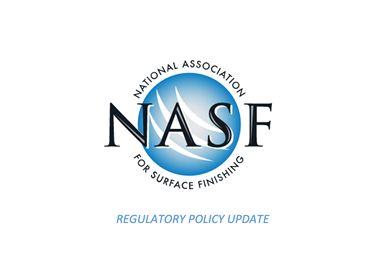NASF Releases Public Policy Update for August 2021
The National Association for Surface Finishing has released its monthly Policy Update, summarizing some of the pertinent regulatory developments and new announcements from the month of August.

The National Association for Surface Finishing (NASF) Government Affairs team has released an update regarding its engagement during the month of August on an array of new rules and initiatives from Washington D.C.
The update includes the following stories:
- OSHA’s revised COVID guidance for non-healthcare workplaces http://short.pfonline.com/osha081621
- The Senate approves a still-massive bipartisan infrastructure bill http://short.pfonline.com/infra81621
- Environmental Working Group targets 4,700 surface finishing facilities as suspected sources of PFAS contamination http://short.pfonline.com/EWG081621
- EPA and Army Corps of Engineers Announce Plans for Revising Major US Waters Rule http://short.gardnerweb.com/h2o081621
- EPA’s expanded powers to regulate a wider universe of substances as hazardous air pollutants http://short.gardnerweb.com/haps081621
- EPA is extending the comment deadline for its proposed PFAS reporting rule http://short.pfonline.com/com081621
- California proposes new public health goals for PFOS and PFOA http://short.pfonline.com/pfas081621
- NASF and California Chapters engage regional water boards on PFAS sampling order. http://short.pfonline.com/pfas281621
This update is courtesy of the National Association for Surface Finishing (NASF). For more information or to become a member, visit nasf.org.
Related Content
-
Conferences, Trade Shows, Tours and Events
Products Finishing rounds up some of its recent travels — from international trade shows to facility tours to legislative meetings regarding environmental regulations affecting the finishing community.
-
OSHA, DOT and EPA Penalties Increase for 2023
The Department of Labor to revise civil penalty amounts for employer OSHA violations.
-
Reducing VOCs
Coating materials (paint and solvent) are one of the most significant sources of VOC generation. John Owed of Carlisle Fluid Technologies offers advice for reducing VOC consumption.









.jpg;maxWidth=300;quality=90)


